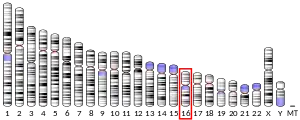LRRC50
Leucine-rich repeat-containing protein 50 is a protein that in humans is encoded by the LRRC50 gene.[5][6]
Function
Leucine-rich repeat-containing protein 50 is cilium-specific and is required for the stability of the ciliary architecture. It is involved in the regulation of microtubule-based cilia and actin-based brush border microvilli.[5]
Clinical significance
Mutations in the LRRC50 gene are associated with primary ciliary dyskinesia.[6]
References
- GRCh38: Ensembl release 89: ENSG00000154099 - Ensembl, May 2017
- GRCm38: Ensembl release 89: ENSMUSG00000031831 - Ensembl, May 2017
- "Human PubMed Reference:". National Center for Biotechnology Information, U.S. National Library of Medicine.
- "Mouse PubMed Reference:". National Center for Biotechnology Information, U.S. National Library of Medicine.
- "Entrez Gene: leucine rich repeat containing 50".
- Duquesnoy P, Escudier E, Vincensini L, Freshour J, Bridoux AM, Coste A, Deschildre A, de Blic J, Legendre M, Montantin G, Tenreiro H, Vojtek AM, Loussert C, Clément A, Escalier D, Bastin P, Mitchell DR, Amselem S (December 2009). "Loss-of-function mutations in the human ortholog of Chlamydomonas reinhardtii ODA7 disrupt dynein arm assembly and cause primary ciliary dyskinesia". Am. J. Hum. Genet. 85 (6): 890–6. doi:10.1016/j.ajhg.2009.11.008. PMC 2790569. PMID 19944405.
Further reading
- van Rooijen E, Giles RH, Voest EE, et al. (2008). "LRRC50, a conserved ciliary protein implicated in polycystic kidney disease". J. Am. Soc. Nephrol. 19 (6): 1128–38. doi:10.1681/ASN.2007080917. PMC 2396934. PMID 18385425.
- Gerhard DS, Wagner L, Feingold EA, et al. (2004). "The status, quality, and expansion of the NIH full-length cDNA project: the Mammalian Gene Collection (MGC)". Genome Res. 14 (10B): 2121–7. doi:10.1101/gr.2596504. PMC 528928. PMID 15489334.
- Ota T, Suzuki Y, Nishikawa T, et al. (2004). "Complete sequencing and characterization of 21,243 full-length human cDNAs". Nat. Genet. 36 (1): 40–5. doi:10.1038/ng1285. PMID 14702039.
- Kimura K, Wakamatsu A, Suzuki Y, et al. (2006). "Diversification of transcriptional modulation: large-scale identification and characterization of putative alternative promoters of human genes". Genome Res. 16 (1): 55–65. doi:10.1101/gr.4039406. PMC 1356129. PMID 16344560.
- Strausberg RL, Feingold EA, Grouse LH, et al. (2002). "Generation and initial analysis of more than 15,000 full-length human and mouse cDNA sequences". Proc. Natl. Acad. Sci. U.S.A. 99 (26): 16899–903. Bibcode:2002PNAS...9916899M. doi:10.1073/pnas.242603899. PMC 139241. PMID 12477932.
- Loges NT, Olbrich H, Becker-Heck A, et al. (2009). "Deletions and point mutations of LRRC50 cause primary ciliary dyskinesia due to dynein arm defects". Am. J. Hum. Genet. 85 (6): 883–9. doi:10.1016/j.ajhg.2009.10.018. PMC 2795801. PMID 19944400.
External links
This article incorporates text from the United States National Library of Medicine, which is in the public domain.
This article is issued from Wikipedia. The text is licensed under Creative Commons - Attribution - Sharealike. Additional terms may apply for the media files.



